Ancient Ships: The Ships of Antiquity
Roman Galleons
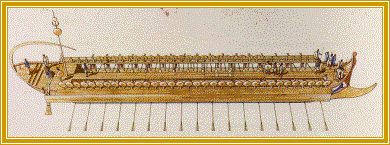
The Marsala Punic War Ship 240BCE
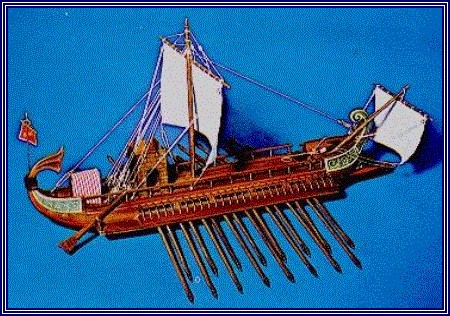
Model Length: 24-1/2" (623mm) Scale: 1/30
provided by Hobby World of Montreal
A typical Roman war ship of the first Century
B.C. this Bireme was driven by two rows of oars. Out riggers stabilized
the ship and the whales protected the hull from the protruding bows
of enemy ships. While fast under oar, this type of vessel capsized
easily under too much sail. This ship was built with plank on bulkhead
construction.
The model is a kit that has been recently
updated. Panart's double-planked hull features laser cut wooden
components. The bow and stern sections, which used to be made of
plastic, are now laser cut out of wood. The oars now come pre shaped
but still require assembly. The fittings are of wood and metal.
Cotton sail clothe, rigging. The silk tent for dignitaries or officers
and the imperial standard of Caesar are silk-screened. Instructions
included.
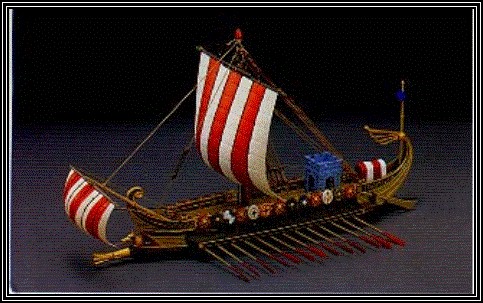
The crew of a liburnia consisted
of about 50-80 oar-men (remiges) and a unit of about 30-50 marines,
depending on the size of the ship. Liburnias were used everywhere
in the roman empire, for e xample on the Nile, Rhine and Danube
rivers. Compared to the fighting value ot the earliest warships
with only one row of oars-men, the liburnia was a more powerful
ship especially when ramming an enemy ship. With a closed
deck it could take more marines as any other ship this size for
the purpose of hand to hand combat helping insure a victory when
fighting at close quarters with a ship of the same size.
The crew of a lubrnia consisted of about 50-80
0ar-men and a unit of 30-50 marines. each varied based on the size
of the ship. These ships were used extensively everywhere in the
Roman empire for example on the Nile, Rhine and Danube-rivers. Compared
to the fighting-value of the earlier warships with only one row
of oar-men, the liburnia was a more powerful ship, especially when
ramming an enemy ship. With a closed deck, it also could take more
marines ("manipularii" in latin) as any other nation's
ship of this size.
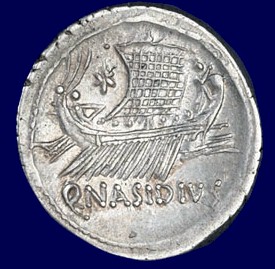
1st Century Roman Galleon as depicted on
a Roman Coin
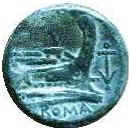
Prow of Ship depicted on a Roman Bronze Coin

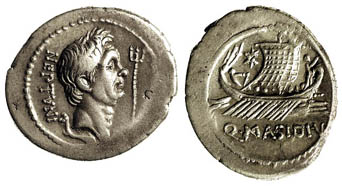
Coin commemorating the naval victories of
Pompeius Magnus During the Mithri dates Wars
The Historic Context of this coin.
THE FIRST TRIUMVIRATE, 60-54 BC
Pompeius Magnus with Julius Ceasar and Crassus
After 30 years of increasing pressure to Roman
shipping and trade from the Greek Empire in the East. In 67, the
tribune Roman Aulus Gabinius forced a bill through the popular assembly
awarding Pompey command of the campaign against the pirates in the
Eastern Mediterranean. Other commanders had been in Anatolia and
the east for some time attempting both to destroy the pirates who
were damaging Roman shipping and trade, and to make a dent against
the ever-troublesome Hellenistic Greek king, Mithridates IV who
ruled out of Pontus.
Mithridate IV had 400 ships of his own in the water
and was supporting the activities of piracy against Roman shipping
and trade in the Eastern Mediterranean.
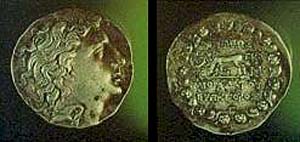
Portrait of Mirthradates IV Front and Pegasus and
Laurel Wreath Back, tetra - drachma, minted with silver in Pontus
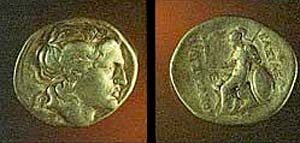
Portrait of Mirthradates IV Front and seated
Athena Back drachma, minted with silver in Pontus
See references to the Mythridatic war. "Mithridatic
War"
"Mithridates
& The Roman Conquests in the East, 90-61 BCE." Translated
selections from Appian and Plutarch with introductory material (Paul
Halsall).
Pompey received his military command in the face
of entrenched political opposition. It was the sheer scale of the
military forces to be allotted to Pompey which created the primary
concern to the Roman Republic and for many it seemed to be a clear
danger signal that Pomp e y may o btain to much power and influence
in the Eastern Empire. Although it was apparent the military campaign
in the east was needed to protect Rome's shipping and trading interests
the assignment of so much military power into the command of one
individual was not a political ly popular position.
THE GREEK KING MITHRIDATES AND THE PIRATES, 67-62
BC
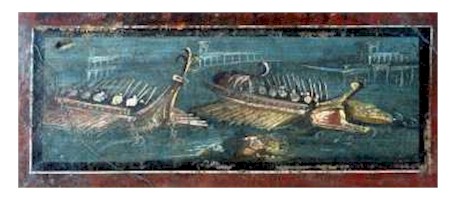
Roman Galleons in Wall Fresco From Pompeii 70 AD
Julius Caesar was one of the Senators who supported
Pompey's command from the start and was later to form strong family
and political alliances with Pompey. The command to conduct the
eastern campaign gave Pompey sole authority over the entire Roman
naval forces available in the Mediterranean and beyond. His leadership
role set him above every other military leader in the E astern
Roman Empire. In three short months (67-66 BC), Pompey's forces
literally swept the Mediterranean free of the pirates. Pompey's
successes helped him become the republic's hero of the hour.
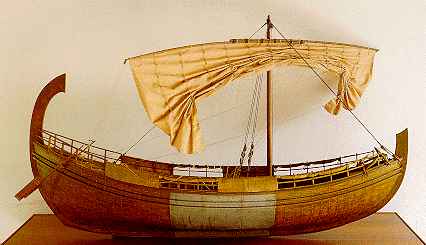
Model of Shipping and Trading vessel of the Mediterranean 1-3 centuries
BCE
Pompey returned to Rome in December
62 to celebrate his third and most magnificent Triumph during his
successful military campaign s in the Eastern Mediterranean .
He was now at his zenith, however by this time Pompey had been largely
absent from Rome for over five years and a new star had arisen with
the young Julius Ceasar. Pompey had been busy in Asia when a young
Julius Caesar pitted his political will against that of the Consul,
Cicero, and the rest of the Optimates. Pompey had been occupied
while new political alliances were being formed in Rome during his
absence.
After returning to Rome, Pompey
dismissed his military command, disarming his political opponents
of grounds for their worries that he intended to spring from his
conquests into domination of Rome. Pompey was a supreme political
as well a s military tactician; he simply sought new allies and
pulled strings behind the political scenes to assert his political
will . However his political opponents failed to affirm his magnificent
victories and the conquering and settlement of the Eastern Roman
Empire.
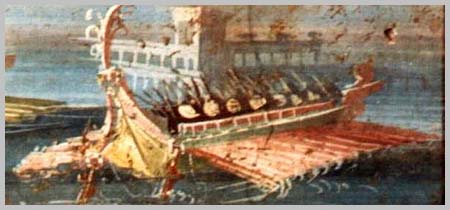
Contemporary Painting of Roman Galleon from walls of Pompeii
To view additional images of Roman Ships please visit. GALLERIA
NAVALE
Pompey found his political opponents prevented
him from to delivering on the promises of the assignment of public
lands to his veterans after the war. Pompey's political maneuverings
suggest that, although he toed a cautious line to avoid offending
the conservatives, he was increasingly frustrated by Optimate reluctance
to acknowledge his solid military and political achievements. Pompey's
ambition to fullfill his promises and the political frustration
s brought about by the opposition of the Optimates would force
him into new and strange political alliances.
POMPEY BECOMES A MEMBER OF THE FIRST TRIUMVIRATE, 60-54 BC
Pompey found he was unable to deliver on the promises
he had made to his veterans for the allocation of public lands.
Although Pompey and Crassus distrusted each other both felt aggrieved
in 61 BCE ; Crassus' tax farming clients were being rebuffed at
the same time Pompey's veterans were being ignored. Caesar who was
six years younger than Pompey and had just returned from service
in Spain ready to seek the Consulship in 59 BC. Caesar in his ambition
somehow managed to forge a political alliances with both Pompey
and Crassus creating the "First Triumvirate" The Triumvirate
would make Caesar Consul and he would help force through the laws
accomplishing their pu r poses in the assembly. Plutarch 's histories
later quotes Cato as saying that the tragedy of Pompey was
not that he was Caesar's defeated enemy, but that he had been, for
too long, Caesar's friend and supporter.
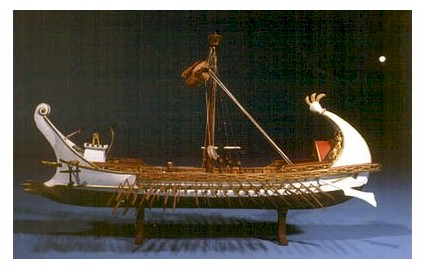 Image Cortesy of the MUSEO TECNICO NAVALE
Image Cortesy of the MUSEO TECNICO NAVALE
Caesar's Consulate brought Pompey the lands and
political settlements he had promised his veterans. Pompey was to
marry Caesar's own young daughter, Julia. Pompey was madly in love
with his young bride. Caesar secured a proconsular command in Gaul
at the end of his Consular year, Pompey was assigned the governorship
of Further Spain. Pompey remained in Rome and govenered Further
Spain through exercising his command of subordinates.
Pompey remained in Rome overseeing the critical
Roman grain supply, Pompey handled the transportation and trade
in grain with his usual excellent efficiency but his success at
political intrigue was less compelling. The Optimates had never
forgiven him for abandoning Cicero when Publius Clodius forced his
exile; only when Clodius began attacking Pompey was the great man
persuaded to work with others towards Cicero's recall in 57. Once
Cicero was back, his usual vocal magic helped soothe Pompey's previous
unfavorable political position somewhat, but many still viewed him
as a traitor for his alliance with Caesar. Other agitators (including
Clodius) tried to persuade Pompey that Crassus was plotting to have
him assassinated. Rumor (quoted by Plutarch) also suggested that
the aging conqueror was losing interest in politics in favor of
domestic life with his young wife. He was occupied by the details
of construction of the mammoth complex later known as Pompey's Theater
on the Campus Martius; not only the first permanent theater ever
built in Rome, but an eye-popping complex of lavish porticoes, shops,
and multi-service buildings . Within this architectural complex
also happened to be the location where Caesar was to be assassinated
in 44 BC.
This text is a partial extract from the web site
Gnaeus
Pompeius Magnus, 106-47 BC written and edited by Suzanne
Cross © 2001. All Rights Reserved. The copy has been rewritten
and modified to explain the historic context for the minting of
the coins with the images of Roman Ships.
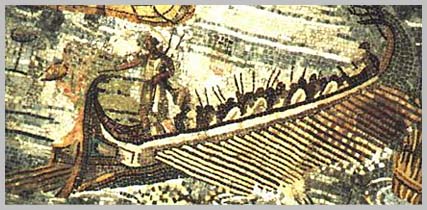
To view additional images of Roman Ships please visit.
GALLERIA NAVALE (in Italian) - Roman Naval Gallery:
A selection of Roman naval images
(frescoes, mosaics, bas-reliefs, sculptures, coins and other findings)
published on «Classica» or on the Net.
[GALLERIA
1] - [GALLERIA
2] - [GALLERIA
3]
[GALLERIA
4] - [GALLERIA
5] - [GALLERIA
6]

Previous |
Next
| Table Of Contents

|

